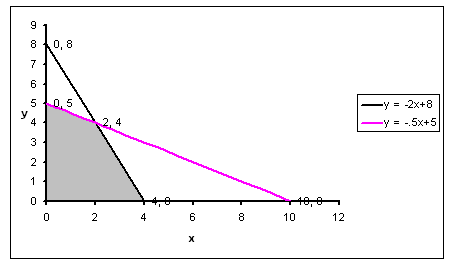
To find: the coordinates of all the vertices and determine whether the solution set bounds or not.
Answer to Problem 25E
The vertices are
The solution set is bounded
Explanation of Solution
Given:
Calculation:
We obtain the equations from the given inequalities as
From these two equations, solve for
Substitute
Therefore, the intersection point of the two equations is (2,4) .
We graph the lines given by the equations that correspond to each inequality. To determine the graphs of the linear inequalities, we need to check our test point. Here, we take (0,0) as test point.
| Inequality | Test point (0,0) | Conclusion |
| Satisfied inequality | ||
| Satisfied inequality |
Since (0,0) is below the lines
Therefore, graph with shaded region is

Vertices:- The co-ordinate of one vertex is the point of intersection of the given lines, which is clearly (2,4). The origin (0,0) is also a vertex. The other two vertices are at the
Therefore, the vertices are
From the figure it is clear that the shaded region is bounded. Therefore, the solution set is bounded
Conclusion:
Therefore, the vertices are
Chapter 10 Solutions
Precalculus: Mathematics for Calculus - 6th Edition
 Calculus: Early TranscendentalsCalculusISBN:9781285741550Author:James StewartPublisher:Cengage Learning
Calculus: Early TranscendentalsCalculusISBN:9781285741550Author:James StewartPublisher:Cengage Learning Thomas' Calculus (14th Edition)CalculusISBN:9780134438986Author:Joel R. Hass, Christopher E. Heil, Maurice D. WeirPublisher:PEARSON
Thomas' Calculus (14th Edition)CalculusISBN:9780134438986Author:Joel R. Hass, Christopher E. Heil, Maurice D. WeirPublisher:PEARSON Calculus: Early Transcendentals (3rd Edition)CalculusISBN:9780134763644Author:William L. Briggs, Lyle Cochran, Bernard Gillett, Eric SchulzPublisher:PEARSON
Calculus: Early Transcendentals (3rd Edition)CalculusISBN:9780134763644Author:William L. Briggs, Lyle Cochran, Bernard Gillett, Eric SchulzPublisher:PEARSON Calculus: Early TranscendentalsCalculusISBN:9781319050740Author:Jon Rogawski, Colin Adams, Robert FranzosaPublisher:W. H. Freeman
Calculus: Early TranscendentalsCalculusISBN:9781319050740Author:Jon Rogawski, Colin Adams, Robert FranzosaPublisher:W. H. Freeman
 Calculus: Early Transcendental FunctionsCalculusISBN:9781337552516Author:Ron Larson, Bruce H. EdwardsPublisher:Cengage Learning
Calculus: Early Transcendental FunctionsCalculusISBN:9781337552516Author:Ron Larson, Bruce H. EdwardsPublisher:Cengage Learning





